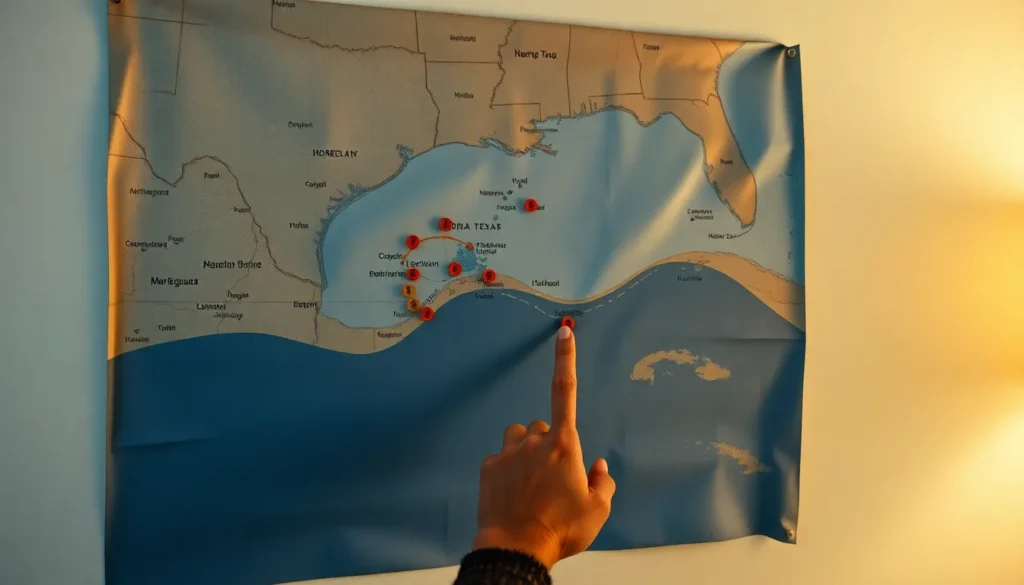Table of Contents
ToggleAs Hurricane Beryl churns in the Atlantic, many are left wondering about its potential impact on coastal cities like Houston. With the unpredictable nature of hurricanes, residents are keen to stay informed and prepared. The storm’s trajectory and intensity can change rapidly, making it crucial to monitor updates from reliable sources.
Houston, known for its resilience in the face of natural disasters, has faced hurricanes before. However, the question remains: will Beryl make landfall in this vibrant city? Understanding the storm’s path and possible effects can help residents take necessary precautions. As forecasts evolve, staying informed is key to ensuring safety and readiness.
Overview of Hurricane Beryl
Hurricane Beryl, a significant weather system, exhibits patterns typical of hurricane formations. As of the latest reports, Beryl has developed maximum sustained winds reaching up to 80 mph, placing it in the Category 1 hurricane classification. The storm’s central pressure measures approximately 985 millibars, indicating strength.
Hurricane Beryl poses potential threats to coastal areas due to its projected path. Current tracking models suggest a trajectory that may shift toward the Gulf of Mexico, which includes major cities like Houston. These shifts can occur with little warning, emphasizing the necessity for residents to remain vigilant and monitor updates.
Emergency services and local governments urge Houston residents to prepare for severe weather conditions, including high winds and heavy rainfall. The storm may cause flooding, power outages, and hazardous travel conditions. Staying informed through trusted weather sources and adhering to guidance from local authorities is crucial for ensuring safety during the storm’s approach.
Preparedness actions include having emergency kits stocked with essentials, securing outdoor items, and reviewing evacuation routes. These measures provide the best defense against the unpredictable behavior of hurricanes like Beryl.
Current Path and Trajectory

Hurricane Beryl’s path remains uncertain, presenting potential threats to Houston. Meteorologists continuously analyze factors that could influence its trajectory and intensity.
Meteorological Factors Affecting Houston
Meteorological elements play a crucial role in assessing Hurricane Beryl’s impact on Houston. Key factors include:
- Wind Patterns: Steering winds at various atmospheric levels can alter the hurricane’s course, pushing it towards or away from the Texas coast.
- Temperature: Warmer sea surface temperatures in the Gulf enhance hurricane strength, potentially increasing rainfall and wind speeds impacting Houston.
- Pressure Systems: High-pressure and low-pressure systems can interact with Beryl, either steering it towards Houston or causing it to veer off course.
Historical Patterns of Hurricanes in Houston
Houston’s history illustrates varying hurricane impacts, emphasizing the need for preparedness. Notable historical occurrences include:
- Hurricane Harvey (2017): Brought catastrophic flooding, with estimated rainfall exceeding 50 inches in some areas.
- Hurricane Ike (2008): Caused widespread power outages and significant coastal damage, affecting approximately 1.5 million homes.
- Hurricane Rita (2005): Triggered mass evacuation efforts and large-scale disruptions, affecting traffic for miles.
Understanding these patterns helps residents recognize the importance of readiness in the face of potential threats from Hurricane Beryl.
Potential Impact on Houston
Hurricane Beryl poses a potential risk to Houston as it approaches the Gulf of Mexico. Local authorities and meteorologists are monitoring the situation closely and providing updated information to keep residents informed.
Wind Speeds and Rainfall Predictions
Beryl currently holds a Category 1 classification with maximum sustained winds of 80 mph. As it progresses, the storm may strengthen or weaken, influencing wind speeds. Rainfall predictions indicate potential accumulation between 3 to 6 inches, with localized areas possibly receiving higher amounts. Flooding risks are heightened if these predictions materialize, especially in areas with poor drainage.
Emergency Response Preparedness
Emergency response plans are crucial in mitigating risks associated with Hurricane Beryl. Local governments encourage residents to:
- Stock Emergency Kits: Gather supplies such as water, non-perishable food, medications, and flashlights. Ensure kits contain enough provisions for at least three days.
- Secure Outdoor Items: Anchor or store items that could become projectiles in high winds, such as patio furniture, garden tools, and decorations.
- Review Evacuation Routes: Familiarize oneself with potential evacuation routes and local shelters in case of severe weather conditions.
- Stay Informed: Follow local news, weather updates, and alerts from the National Hurricane Center for real-time information on Beryl’s trajectory and impact.
Adhering to these preparedness steps enhances safety during the storm’s approach.
Public Awareness and Safety Measures
Residents must stay informed about Hurricane Beryl’s trajectory and potential impacts. Awareness and preparation are key to ensuring safety during severe weather events.
Resources for Staying Informed
- National Weather Service: Provides real-time updates and forecasts, including alerts for severe weather.
- Local News Outlets: Offer continuous coverage of the storm’s development, including live updates, interviews with meteorologists, and community safety information.
- Mobile Apps: Utilize weather apps that deliver notifications for hazardous weather conditions and safety alerts directly to smartphones.
- Social Media: Follow local government and emergency management accounts for timely updates regarding public safety and evacuations.
- NOAA Weather Radio: Transmits continuous broadcasts of weather information, including emergency alerts specific to the local area.
Community Preparedness Initiatives
- Evacuation Drills: Local authorities conduct regular drills to prepare communities for potential evacuations and ensure the public knows safe routes and designated shelters.
- Public Workshops: Educational programs focus on hurricane preparedness, teaching residents how to create emergency kits and develop family emergency plans.
- Neighborhood Watch Programs: Encourage community collaboration and communication, allowing residents to support one another during storm responses.
- Local Relief Organizations: Coordinate resources and assistance for those impacted by storms, including food, shelter, and medical aid.
- Emergency Services Collaborations: Foster partnerships between local law enforcement, fire departments, and medical services to streamline disaster responses and enhance community safety.
Hurricane Beryl poses a significant concern for Houston residents as its path remains uncertain. The unpredictability of hurricanes underscores the necessity for proactive measures and vigilance. With potential heavy rainfall and flooding on the horizon, it’s crucial for individuals to stay informed and prepared.
Local authorities and meteorologists are committed to providing timely updates, ensuring the community remains aware of any changes in the storm’s trajectory. By taking appropriate precautions and staying connected to reliable sources, Houston residents can better navigate the challenges posed by Hurricane Beryl. Safety and preparedness are paramount as the storm approaches.




